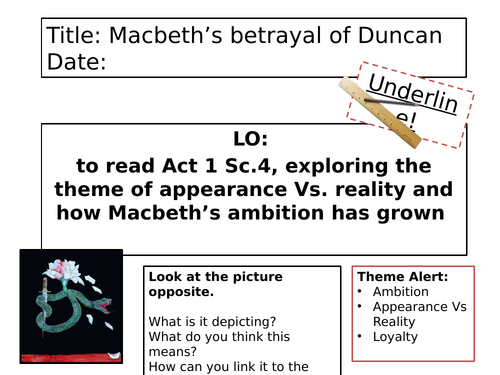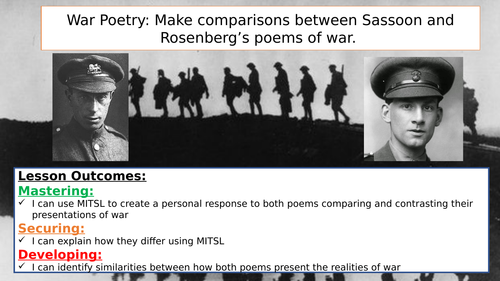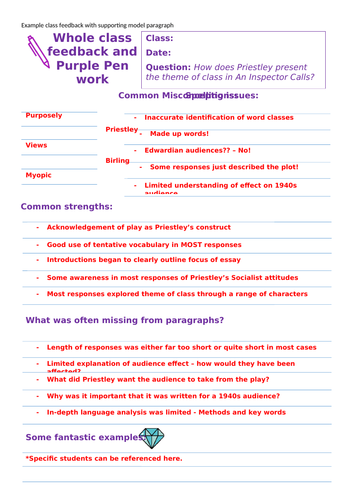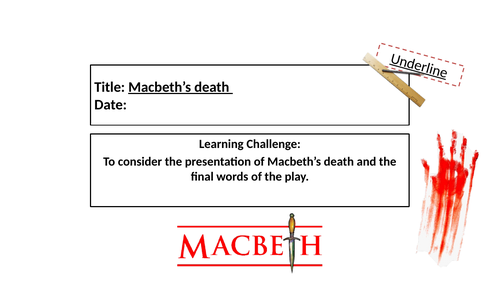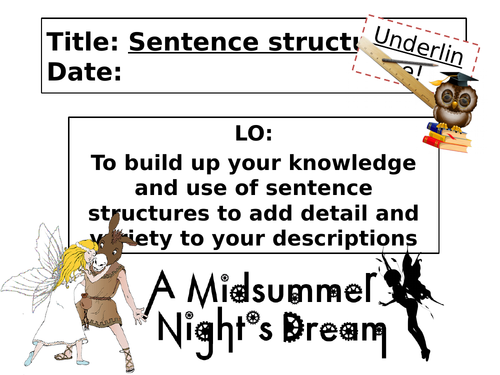45Uploads
18k+Views
3k+Downloads
All resources

Macbeth - Act 1 Scene 4
A lesson exploring the use of contrasts in Act 1 Scene 4 of Macbeth.
Suitable for high ability KS3 (might need simplifying slightly) and KS4.

War Poetry KS3
A set of 3 lessons focusing on two World War 1 poems; Siegfried Sassoon (Counter-Attack) and Isaac Rosenberg (Break of Day in the Trenches) plus a comparison lesson. Suitable for KS3 or low ability KS4.

Macbeth - Act 1 Scene 1
A lesson introducing students to the opening scene of the play (The Witches).
Lesson includes annotations on the scene, a model paragraph and sentence stems for students to explore the use of language to create tension in the scene.
Suitable for high ability KS3 and KS4.

An Inspector Calls - Model paragraph and whole class feedback sheet
Example Whole Class Feedback sheet for an essay on the theme of class in An Inspector Calls.
Accompanied by a model introduction and main paragraph (teacher written).
Can be used to help scaffold student redrafting following an exam response on the question: How does Priestley present the theme of class in An Inspector Calls?

A Thousand Splendid Suns - model introduction and topic sentences
A Level English Literature: A Thousand Splendid Suns
This resource aims to develop A Level students’ ability to conceptualise and structure an exam response to the Prose text A Thousand Splendid Suns.
Students chose one of two exam questions:
How does Hosseini explore ideas of loss in A Thousand Splendid Suns?
OR
How does Hosseini present female suffering in A Thousand Splendid Suns?
Following individual teacher feedback, students were required to improve their responses with a specific focus on introductions and topic sentences to create a clearer structure to their answers.
This resource contains a model introduction and model topic sentences for students to use as a guide.

AQA English Lang Paper 1 model answers
Teacher written Band 4 model answers to support student understanding of questions 2-4 of AQA English Lang Paper 1 Section A.
These model answers are to be used alongside the AQA sample paper that uses the opening from the novel The Clan of the Cave Bear by Jean M. Auel which can be downloaded for free online.

AQA Unseen Poetry model essay
This model essay can be used to develop student understanding of the 24-mark Unseen Poetry question on AQA English Literature Paper 2.
This model essay uses the poem Blessing by Imtiaz Dharker and explores the following exam practice question:
In the poem Blessing, how does the poet present experiences of poverty?

A Christmas Carol - Ignorance and Want
This PPT lesson explores the symbolism and significance of Ignorance and Want, analysing a short extract and considering how Dickens uses language to convey wider purpose and meaning.
The resource includes a worksheet analysing the scene with Ignorance and Want at the end of Stave 3.

Family in A Christmas Carol - Exam revision
This PPT requires students to already have a working knowledge of the text.
The lesson aims to prepare students for an exam question on the theme of FAMILY in A Christmas Carol, based on the AQA GCSE specification.
Students will consider the importance of the theme and it’s links to Dickens’ overall authorial message. The lesson includes teacher notes, a model introduction and a model main paragraph to demonstrate the skills needed for this paper.

Macbeth's death Act 5 Scenes 6-8
Lesson learning challenge: To consider the presentation of Macbeth’s death and the final words of the play.
Lesson includes:
Brief overview of scenes 6-7
Reading of scene 8
analysis questions on an extract from scene 8
Exploration of Macbeth’s ambition across the play
Exploration of the cyclical structure of the play
Analysis questions focusing on Malcolm’s final speech at the end of the play
Analysis of Shakespeare’s message about kingship/leadership

Macbeth Act 5 Scene 5
Lesson learning challenge: To consider the presentation of Macbeth and his attitudes towards his life and fate in Act 5 Scene 5.
Lesson includes:
Brief overview of Act 5 Scenes 2-4
Reading of Scene 5
Exploration of Macbeth’s soliloquy from Scene 5
Full detailed annotations of this soliloquy
Analysis of the structural significance of this scene

AQA English Language Paper 2 Q2 and Q3
An A3 worksheet designed to scaffold the skills students will need to answer Q2 and Q3 of the AQA Paper 2 Language exam.
The resource uses 2 extracts (21st and 19th Century) looking at the life of PT Barnum. As a starter, I got my students to watch the trailer for The Greatest Showman and we discussed what inferences we could make from the film's portrayal of him.
We then looked at the extracts and worked through the first few boxes on the worksheet together. They then completed at independent paragraph on Q3.
Suitable for KS4 students.

KS3 Persuasive Speech writing
A lesson designed to get students thinking about what makes a successful and persuasive speech. Students analyse a famous speech by Churchill, analysing the language used and commenting on the effect.

KS3 Speech Writing - Set of two lessons
Two lessons looking at speech writing using WW1 as a stimulus. Students analyse a speech from Private Peaceful and use it to plan and write their own persuasive speech.

Approaching an unseen poem
KS4 lesson aimed at showing students how to approach an unseen poem for this element of their Literature GCSE exam. Students begin by analysing a model paragraph for Mametz Wood, discussing how it relates to the exam mark scheme. They then explore the poem Against Road Building by Sophie Hannah using the MITSL structure. Finally they will complete a timed response.

KS3 Non-Fiction Writing
A set of two lessons exploring the persecution of Jews during WW2, to act as a stimulus for non-fiction letter and diary writing. Would be useful alongside a study of The Boy in the Striped Pyjamas or other WW2 related fiction texts.

Sentence types
A lesson that focuses on developing knowledge of sentence types for use with Midsummer Night’s Dream Writing SOW but could be used as a standalone descriptive writing lesson. Includes an overview of minor, simple, compound and complex sentences, a task that gets students to identify the different sentence types in a model paragraph, a writing task that uses an image of Bottom from MSND but could be replaced with any image, and a peer assessment task.
Suitable for KS3 and KS4 students.

Introduction to Descriptive Writing
A detailed lesson that introduces students to descriptive writing. The lesson includes a spelling test, a success criteria activity, a variety of descriptive model paragraphs and a plenary that focuses on upscaling vocabulary.
Would be suitable for both KS3 and KS4 students.

Descriptive Writing - Punctuation
A lesson that seeks to develop the use of semi-colons in descriptive writing in order to add detail. The lesson includes a punctuation practice starter, an overview of semi-colon use, an upscaling your sentence task and an independent task where students apply what they have learnt.

Descriptive Writing DIRT
A lesson useful following a descriptive writing assessment. Includes a spelling test starter, sentence development task and upscaling vocabulary tasks, a class model activity and individual improvement task.
DIRT = Directed Improvement and Reflection Time.
Can be adapted to suit any marking and feedback policy.

